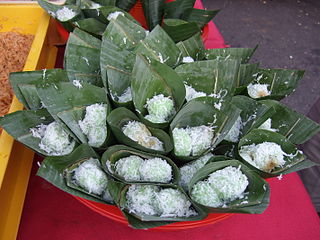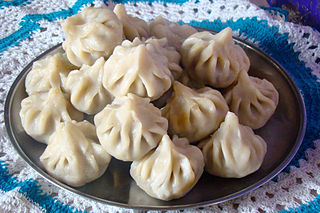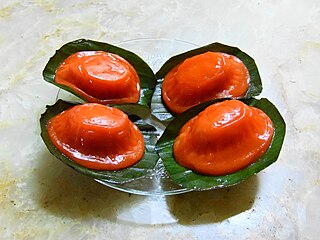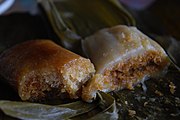
Glutinous rice is a type of rice grown mainly in Southeast and East Asia, and the northeastern regions of South Asia, which has opaque grains, very low amylose content, and is especially sticky when cooked. It is widely consumed across Asia.

Malay cuisine is the traditional food of the ethnic Malays of Southeast Asia, residing in modern-day Malaysia, Indonesia, Singapore, Brunei, Southern Thailand and the Philippines as well as Cocos Islands, Christmas Island, Sri Lanka and South Africa.

Kuih are bite-sized snack or dessert foods commonly found in Southeast Asia and China. It is a fairly broad term which may include items that would be called cakes, cookies, dumplings, pudding, biscuits, or pastries in English and are usually made from rice or glutinous rice. In China, where the term originates from, kueh or koé (粿) in the Min Nan languages refers to snacks which are typically made from rice but can occasionally be made from other grains such as wheat. The term kuih is widely used in Malaysia, Brunei, and Singapore, kueh is used in Singapore and Indonesia, kue is used in Indonesia only, all three refer to sweet or savoury desserts.

A rice cake may be any kind of food item made from rice that has been shaped, condensed, or otherwise combined into a single object. A wide variety of rice cakes exist in many different cultures in which rice is eaten and are particularly prevalent in Japan. Common variations include cakes made with rice flour, those made from ground rice, and those made from whole grains of rice compressed together or combined with some other binding substance.

Tangyuan are a traditional Chinese dessert made of glutinous rice shaped into balls that are served in a hot broth or syrup. They come in varying sizes, anything between a marble to a ping pong ball, and are sometimes stuffed with filling. Tangyuan are traditionally eaten during the Lantern Festival, but because the name is a homophone for union and symbolizes togetherness and completeness, this dish is also served at weddings, family reunions, Chinese New Year, and the Dōngzhì festival.

Peranakan cuisine or Nyonya cuisine comes from the Peranakans, descendants of early Chinese migrants who settled in Penang, Malacca, Singapore and Indonesia, inter-marrying with local Malays. In Baba Malay, a female Peranakan is known as a nonya, and a male Peranakan is known as a baba. The cuisine combines Chinese, Malay, Javanese, South Indian, and other influences.

Kue is an Indonesian bite-sized snack or dessert food. Kue is a fairly broad term in Indonesian to describe a wide variety of snacks including cakes, cookies, fritters, pies, scones, and patisserie. Kue are made from a variety of ingredients in various forms; some are steamed, fried or baked. Kue are popular snacks in Indonesia, which has the largest variety of kue. Because of the countries' historical colonial ties, Koeé (kue) is also popular in the Netherlands.

Putu piring is a round-shaped steamed rice flour kueh (dessert) or sweet snack filled with palm sugar popular in Singapore. Commonly associated with Singaporean cuisine, it is usually made using stainless steel molds with a distinctive flower shape. It is a traditional dessert among the Malay community of the country.

Pineapple tart is a small, bite-size tart filled or topped with pineapple jam, commonly found throughout different parts of Southeast Asia such as Indonesia, Malaysia, Brunei and Singapore in various forms.

Klepon or kelepon, also known outside Java as onde-onde, is a snack of sweet rice cake balls filled with molten palm sugar and coated in grated coconut. Of Javanese origin, the green-coloured glutinous rice balls are one of the popular traditional kue in Indonesian cuisine.

Modakam , also referred to as Koḻukattai (கொழுக்கட்டை) in Tamil, is an Indian sweet dumpling dish popular in many Indian states and cultures. According to Hindu and Buddhist beliefs, it is considered one of the favourite dishes of Lord Ganesha and the Buddha and is therefore used in prayers. The sweet filling on the inside of a modak consists of freshly grated coconut and jaggery, while the outer soft shell is made from rice flour or wheat flour mixed with khava or maida flour.

Kuih seri muka, sri muka or putri salat is a Banjarese and Malay two-layered dessert with steamed glutinous rice forming the bottom half and a green custard layer made with pandan juice. Coconut milk is a key ingredient in making this kue. It is used to impart creamy taste when cooking the glutinous rice and making the custard layer. This kue is found in Indonesia, Malaysia and Singapore.

Ang ku kueh, also known as red tortoise cake, is a small round or oval-shaped Chinese pastry with soft, sticky glutinous rice flour skin wrapped around a sweet central filling. It is molded to resemble a tortoise shell and is presented resting on a square piece of banana leaf. As suggested by its name, red tortoise cakes are traditionally red in color and has a sticky, chewy texture when eaten. Red tortoise cakes are shaped like tortoise shells because the Chinese traditionally believed that eating tortoises would bring longevity to those who are eating it and bring about good fortune and prosperity. Considered to be auspicious items, these sweet pastries are especially prepared during important festivals such as Chinese New Year as offerings to the Chinese deities.

Kue putu or putu bambu is an Indonesian kue. It is made of rice flour called suji and coloured green with pandan leaves, filled with palm sugar, steamed in bamboo tubes, and served with desiccated coconut. This traditional bite-sized snack is commonly found in maritime Southeast Asia, particularly in Java, Indonesia, where it is called putu bumbung. Kue putu is usually sold by street vendors and can be found in traditional markets, along with other kues. Kue putu can also be found in the Netherlands due to its colonial ties with Indonesia.

Kueh Pie Tee is a thin and crispy pastry tart shell kuih often filled with a spicy, shredded Chinese turnips, sweet mixture of thinly sliced vegetables and prawns. It is a popular Peranakan dish, that is often consumed during Chinese New Year or tea parties. The shells are made of flour and though some stores will make them from scratch, they can usually be found ready made in most supermarkets. Similar to popiah, the main filling is shredded jicama and carrots, and usually these two dishes are sold by the same stall in hawker centres.

Apam balik also known as Martabak Manis ,, terang bulan, peanut pancake or mànjiānguǒ, is a sweet dessert originating in Fujian cuisine which now consists of many varieties at specialist roadside stalls or restaurants throughout Brunei, Indonesia, Malaysia and Singapore. It can also be found in Hong Kong as and Taiwan as.

Kue semprong, Asian egg roll, sapit, sepit, kue Belanda, or kapit, is an Indonesian traditional wafer snack made by clasping egg batter using an iron mold which is heated up on a charcoal stove. It is commonly found in Indonesia, Malaysia, Singapore and Brunei.

Kue cucur (Indonesian) or kuih cucur (Malay), known in Thai as khanom fak bua or khanom chuchun, is a traditional snack from Indonesia, and popular in parts of Southeast Asia, includes Indonesia, Malaysia, southern Thailand and Singapore. In Indonesia, kue cucur can be found throughout traditional marketplaces in the country; the popular version, however, is the Betawi version from Jakarta. In Brunei and Malaysia, the term cucur is generally used to refer to any type of fritters. A popular type of cucur in Brunei and Malaysia is Jemput-jemput and Pinjaram. In Southern Thailand, it is often featured in wedding ceremonies and festivals.

Betawi cuisine is rich, diverse and eclectic, in part because the Betawi people that create them were composed from numbers of regional immigrants that came from various places in the Indonesian archipelago, as well as Chinese, Indian, Arab, and European traders, visitors and immigrants that were attracted to the port city of Batavia since centuries ago.




















